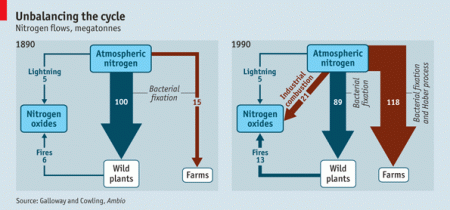- Poverty doesn’t drive deforestation. Discuss using examples from Kenya and China.
- Crop Science Society of America (CSSA) position statement on “Crop Adaptation to Climate Change.” Genebanks mentioned. Crop wild relatives mentioned. Information systems mentioned. One’s cup runneth over.
Nibbles: SusAg WWF-style, Obesity, Innovation, African farmers, Cyanobacteria, Climate change experiment
- See what WWF thinks will make agriculture sustainable.
- Americans are dying younger. Obesity partly to blame.
- Study shows how scientists can get farmers to innovate. And vice versa?
- Iron-age beer in France. “Beer … might have resembled modern home brews.” Which might have created a nation of wine-drinkers.
- Voice of America ♥ Nourishing the Planet. (African farmers also important.)
- Bacteria in mosses on tree branches fertilize forest soils. How long before the whole thing is available in a packet?
- Bioengineering the prairie. Together with, presumably, its crop wild relatives.
Nibbles: Cattle affected, Conservation, Wildfires, Grains, Sudan’s PGR, Sunflowers
- Rare breed of cattle affected by climate change.
- MoBot to host conference on Global Plant Conservation Strategy, 5-7 July 2011
- Russian wildfires expected to be worse this year. What price wheat?
- GOOD gets its head around the meaning of “grain”. As in “15-grain bread in supermarkets”.
- Sudan Agricultural Research Corporation’s Plant Genetic Resources Programme popped up in my Reader. No idea why.
- Uganda’s farmers discover the value of sunflowers.
Where will the protein come from?
As everyone and her dog ventures an opinion of how much more food will be needed to properly feed how many more mouths by when, it is worth bearing in mind an idea that was a little bit hidden in Oliver Morton’s wonderful introduction to The Anthropocene, in The Economist a couple of weeks ago.
Although nitrogen fixation is not just a gift of life — it has been estimated that 100m people were killed by explosives made with industrially fixed nitrogen in the 20th century’s wars — its net effect has been to allow a huge growth in population. About 40% of the nitrogen in the protein that humans eat today got into that food by way of artificial fertiliser. There would be nowhere near as many people doing all sorts of other things to the planet if humans had not sped the nitrogen cycle up.
There’s a chart, too.
Industrial nitrogen fixation does not, of course, require oil, but it does require lots of cleaner, cheaper energy, and there’s still no sign of that just around the corner.
Nibbles: Wheat disease, Dried vegetables, Gates spending in Africa, Canadian spending in India, Ethiopian wheat
- Wheat disease understood; sequence of leaf blotch fungus.
- Wheat disease conquered? “Super varieties” resistant to UG99 and yield 15% more. What could go wrong?
- Zambian farmers urged to dry vegetables for fun and profit (and better nutrition).
- Gates Foundations has spent US$1.7 billion on agriculture in Africa, so far.
- Swaminathan Foundation scores Canadian support for research on agriculture, poverty and nutrition. h/t PAR.
- Bioversity Seeds for Needs distributes preselected genebank wheat varieties to Ethiopian women farmers to adapt to climate change.
